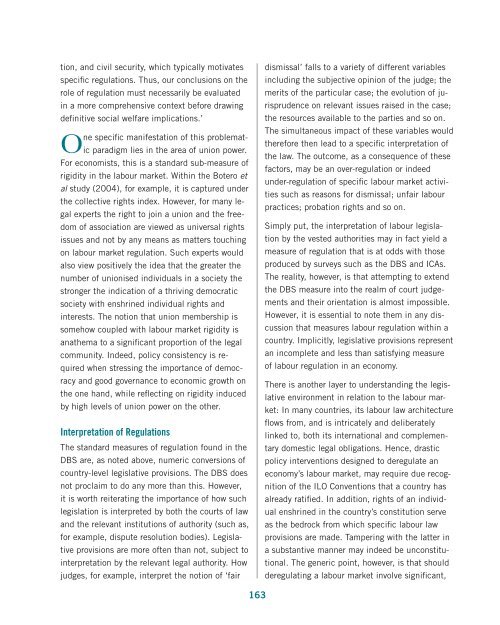Download the file - United Nations Rule of Law
Download the file - United Nations Rule of Law
Download the file - United Nations Rule of Law
Create successful ePaper yourself
Turn your PDF publications into a flip-book with our unique Google optimized e-Paper software.
tion, and civil security, which typically motivatesspecific regulations. Thus, our conclusions on <strong>the</strong>role <strong>of</strong> regulation must necessarily be evaluatedin a more comprehensive context before drawingdefinitive social welfare implications.’One specific manifestation <strong>of</strong> this problematicparadigm lies in <strong>the</strong> area <strong>of</strong> union power.For economists, this is a standard sub-measure <strong>of</strong>rigidity in <strong>the</strong> labour market. Within <strong>the</strong> Botero etal study (2004), for example, it is captured under<strong>the</strong> collective rights index. However, for many legalexperts <strong>the</strong> right to join a union and <strong>the</strong> freedom<strong>of</strong> association are viewed as universal rightsissues and not by any means as matters touchingon labour market regulation. Such experts wouldalso view positively <strong>the</strong> idea that <strong>the</strong> greater <strong>the</strong>number <strong>of</strong> unionised individuals in a society <strong>the</strong>stronger <strong>the</strong> indication <strong>of</strong> a thriving democraticsociety with enshrined individual rights andinterests. The notion that union membership issomehow coupled with labour market rigidity isana<strong>the</strong>ma to a significant proportion <strong>of</strong> <strong>the</strong> legalcommunity. Indeed, policy consistency is requiredwhen stressing <strong>the</strong> importance <strong>of</strong> democracyand good governance to economic growth on<strong>the</strong> one hand, while reflecting on rigidity inducedby high levels <strong>of</strong> union power on <strong>the</strong> o<strong>the</strong>r.Interpretation <strong>of</strong> RegulationsThe standard measures <strong>of</strong> regulation found in <strong>the</strong>DBS are, as noted above, numeric conversions <strong>of</strong>country-level legislative provisions. The DBS doesnot proclaim to do any more than this. However,it is worth reiterating <strong>the</strong> importance <strong>of</strong> how suchlegislation is interpreted by both <strong>the</strong> courts <strong>of</strong> lawand <strong>the</strong> relevant institutions <strong>of</strong> authority (such as,for example, dispute resolution bodies). Legislativeprovisions are more <strong>of</strong>ten than not, subject tointerpretation by <strong>the</strong> relevant legal authority. Howjudges, for example, interpret <strong>the</strong> notion <strong>of</strong> ‘fairdismissal’ falls to a variety <strong>of</strong> different variablesincluding <strong>the</strong> subjective opinion <strong>of</strong> <strong>the</strong> judge; <strong>the</strong>merits <strong>of</strong> <strong>the</strong> particular case; <strong>the</strong> evolution <strong>of</strong> jurisprudenceon relevant issues raised in <strong>the</strong> case;<strong>the</strong> resources available to <strong>the</strong> parties and so on.The simultaneous impact <strong>of</strong> <strong>the</strong>se variables would<strong>the</strong>refore <strong>the</strong>n lead to a specific interpretation <strong>of</strong><strong>the</strong> law. The outcome, as a consequence <strong>of</strong> <strong>the</strong>sefactors, may be an over-regulation or indeedunder-regulation <strong>of</strong> specific labour market activitiessuch as reasons for dismissal; unfair labourpractices; probation rights and so on.Simply put, <strong>the</strong> interpretation <strong>of</strong> labour legislationby <strong>the</strong> vested authorities may in fact yield ameasure <strong>of</strong> regulation that is at odds with thoseproduced by surveys such as <strong>the</strong> DBS and ICAs.The reality, however, is that attempting to extend<strong>the</strong> DBS measure into <strong>the</strong> realm <strong>of</strong> court judgementsand <strong>the</strong>ir orientation is almost impossible.However, it is essential to note <strong>the</strong>m in any discussionthat measures labour regulation within acountry. Implicitly, legislative provisions representan incomplete and less than satisfying measure<strong>of</strong> labour regulation in an economy.There is ano<strong>the</strong>r layer to understanding <strong>the</strong> legislativeenvironment in relation to <strong>the</strong> labour market:In many countries, its labour law architectureflows from, and is intricately and deliberatelylinked to, both its international and complementarydomestic legal obligations. Hence, drasticpolicy interventions designed to deregulate aneconomy’s labour market, may require due recognition<strong>of</strong> <strong>the</strong> ILO Conventions that a country hasalready ratified. In addition, rights <strong>of</strong> an individualenshrined in <strong>the</strong> country’s constitution serveas <strong>the</strong> bedrock from which specific labour lawprovisions are made. Tampering with <strong>the</strong> latter ina substantive manner may indeed be unconstitutional.The generic point, however, is that shouldderegulating a labour market involve significant,163
















